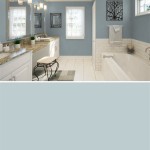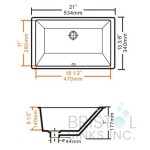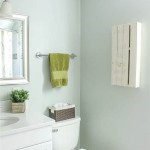What Paint Sheen for Bathroom Ceiling: A Comprehensive Guide
Selecting the appropriate paint sheen for a bathroom ceiling is a crucial consideration during any bathroom renovation or painting project. Bathrooms, by their very nature, are environments characterized by high humidity and frequent temperature fluctuations. Consequently, the chosen paint sheen must be able to withstand these conditions to prevent premature deterioration, mold growth, and an overall unattractive appearance. Understanding the properties of different paint sheens and their suitability for bathroom ceilings is essential for achieving a durable and aesthetically pleasing result.
Paint sheen refers to the degree of light reflection from a painted surface. The sheen level significantly influences the paint's appearance, durability, and cleanability. Generally, higher sheens reflect more light and offer better resistance to moisture and stains. Conversely, lower sheens tend to hide imperfections more effectively but are less durable and harder to clean. The decision of which sheen to use depends on the specific needs and priorities of the project, taking into account factors such as the bathroom's ventilation, the presence of imperfections on the ceiling, and the desired aesthetic.
The following sections will delve into the various paint sheens commonly available and analyze their suitability for bathroom ceilings, providing a comprehensive guide to making informed decisions for bathroom painting projects.
Understanding Different Paint Sheens
Paint sheens are typically categorized based on their gloss level, ranging from flat or matte (lowest gloss) to high gloss (highest gloss). Each sheen possesses distinct characteristics that make it suitable for different applications. In the context of bathroom ceilings, understanding these characteristics is particularly important due to the unique environmental challenges present in bathrooms.
Flat/Matte: Flat or matte sheens have the lowest light reflectivity, creating a non-reflective surface. These sheens excel at concealing imperfections, such as uneven textures or minor blemishes, making them a popular choice for ceilings in general. However, flat paints are porous and less resistant to moisture and stains, making them a poor choice for bathroom ceilings. The high humidity in bathrooms can easily penetrate the paint, leading to blistering, peeling, and mold growth. Cleaning flat paint is also difficult, as scrubbing can damage the surface and create burnishing, where the paint becomes shiny in certain areas.
Eggshell: Eggshell sheen offers a slightly higher level of reflectivity than flat paint, providing a subtle sheen that resembles the surface of an eggshell. It offers a better balance between concealing imperfections and providing some degree of durability. While eggshell is more washable than flat paint, it is still not ideal for areas prone to high moisture exposure. For bathroom ceilings, eggshell may be acceptable in well-ventilated bathrooms with limited shower activity. However, in bathrooms with frequent and steamy showers, a more durable sheen is recommended.
Satin: Satin sheen possesses a higher level of reflectivity than eggshell, resulting in a smoother and more lustrous appearance. It offers improved durability and washability compared to lower sheens, making it a viable option for bathroom ceilings. Satin paint is more resistant to moisture and stains, making it easier to clean and maintain. However, it is still not as durable as higher-gloss options and may show imperfections more readily. Satin is a good compromise for those who want a balance between durability and visual appeal, especially in bathrooms with adequate ventilation.
Semi-Gloss: Semi-gloss paint exhibits a significant level of reflectivity, creating a shiny and durable surface. It is highly resistant to moisture, stains, and mildew, making it an excellent choice for bathroom ceilings. Semi-gloss paint is easy to clean and can withstand frequent scrubbing without damage. While it effectively repels moisture, it also highlights imperfections, so proper surface preparation is crucial. Any unevenness or flaws in the ceiling will be more noticeable with a semi-gloss finish. For bathrooms with high humidity and frequent shower use, semi-gloss provides a reliable and long-lasting option.
High-Gloss: High-gloss paint offers the highest level of reflectivity, creating a very shiny and durable surface. It is extremely resistant to moisture, stains, and mildew, making it the most durable option for bathroom ceilings. High-gloss paint is easy to clean and can withstand frequent scrubbing. However, it also accentuates imperfections to the greatest extent, requiring meticulous surface preparation. The high level of gloss can also be visually overwhelming in some bathrooms. While high-gloss is technically suitable for bathroom ceilings, it is often reserved for trim and accents due to its very shiny appearance. It finds particular application in high-traffic commercial bathrooms due to its high durability.
The Importance of Moisture Resistance in Bathroom Ceilings
Moisture resistance is the paramount consideration when selecting paint for a bathroom ceiling. Bathrooms are inherently humid environments, with moisture generated from showers, baths, and even handwashing. This moisture can condense on the ceiling, creating a breeding ground for mold and mildew if the paint is not adequately resistant. Mold and mildew not only pose health risks but can also damage the ceiling surface, leading to costly repairs.
Paint sheens with higher gloss levels, such as semi-gloss and high-gloss, offer superior moisture resistance compared to lower sheens. The higher density of the paint film in these sheens prevents moisture from penetrating the surface and reaching the underlying drywall or plaster. This resistance helps to prevent mold and mildew growth, ensuring a healthier and more durable ceiling. Paints explicitly formulated for bathrooms often contain mildewcides, which further enhance their resistance to mold and mildew.
Inadequately moisture-resistant paint can lead to a range of problems, including blistering, peeling, and discoloration. Water that penetrates the paint film can cause the paint to lose adhesion and bubble, resulting in an unsightly appearance. The constant exposure to moisture can also weaken the paint film, causing it to crack and peel. Discoloration, often in the form of water stains or mold growth, can further detract from the aesthetic appeal of the bathroom.
Proper ventilation plays a crucial role in reducing moisture buildup in bathrooms and prolonging the life of the paint. Exhaust fans should be used during and after showers and baths to remove excess moisture from the air. Additionally, ensuring adequate airflow throughout the bathroom can help to prevent condensation on the ceiling. Even with proper ventilation, a moisture-resistant paint sheen is essential for protecting the ceiling from the harmful effects of humidity.
Factors to Consider When Choosing a Paint Sheen
While moisture resistance is paramount, several other factors should be considered when selecting a paint sheen for a bathroom ceiling. These factors include the bathroom's ventilation, the presence of imperfections on the ceiling, the desired aesthetic, and the level of maintenance required.
Ventilation: The level of ventilation in the bathroom directly impacts the amount of moisture that accumulates on the ceiling. Bathrooms with poor ventilation require a more moisture-resistant paint sheen to prevent mold and mildew growth. In such bathrooms, semi-gloss or even high-gloss paint may be necessary. Conversely, bathrooms with excellent ventilation may be able to tolerate a slightly lower sheen, such as satin.
Imperfections: The presence of imperfections on the ceiling, such as uneven textures, cracks, or blemishes, can influence the choice of paint sheen. Lower sheens, such as flat or eggshell, excel at concealing imperfections, while higher sheens tend to accentuate them. If the ceiling is relatively smooth and free of imperfections, a higher sheen may be acceptable. However, if the ceiling has numerous imperfections, a lower sheen may be preferred to minimize their visibility.
Aesthetic: The desired aesthetic of the bathroom should also be considered when choosing a paint sheen. Higher sheens, such as semi-gloss and high-gloss, create a shiny and reflective appearance, which can brighten the room and create a more modern look. Lower sheens, such as flat and eggshell, offer a more subtle and understated appearance, which may be preferred in more traditional bathrooms. The choice of sheen should complement the overall design and color scheme of the bathroom.
Maintenance: The level of maintenance required for the bathroom ceiling should also be considered. Higher sheens are generally easier to clean and maintain than lower sheens. They are more resistant to stains and can be easily wiped down with a damp cloth. Lower sheens, on the other hand, are more difficult to clean and may require more frequent repainting. If ease of maintenance is a priority, a higher sheen is a better choice.
In summary, selecting the most suitable paint sheen for a bathroom ceiling demands a careful evaluation of the bathroom’s specific environmental conditions, the state of the ceiling surface, the intended visual effect, and the desired level of maintenance. By balancing these factors, one can ensure that the chosen paint not only withstands the rigors of a humid environment but also contributes to the overall aesthetic appeal and longevity of the bathroom.

The 8 Best White Paint Colors For Trim West Magnolia Charm

A Guide To Choosing The Right Finish For Every Room Specialty Coatings Paintings

Ceiling Paint For Bathroom Home Painters Toronto

Should I Use Flat Paint In A Bathroom Williams Painting

Paint Sheen Guide In 2024 Painting Bathroom

What Is The Best Ceiling Paint Finish Flat Or Eggs With Photos Of 7 Rooms Abbotts At Home

Should I Use Flat Paint In A Bathroom Williams Painting

Best Paint For Steamy Bathroom Ceiling Eco Inc

Best Paint For Bathroom Ceilings

What Type Of Paint Should I Use In My Bathroom
See Also







